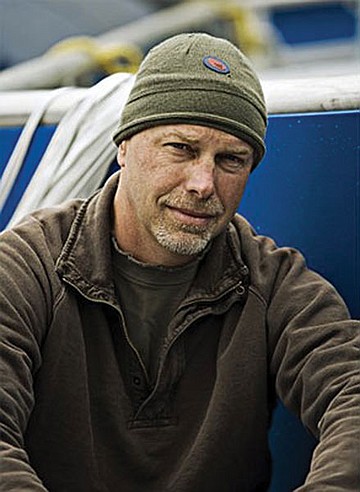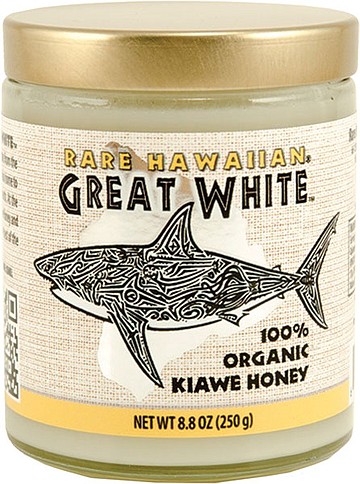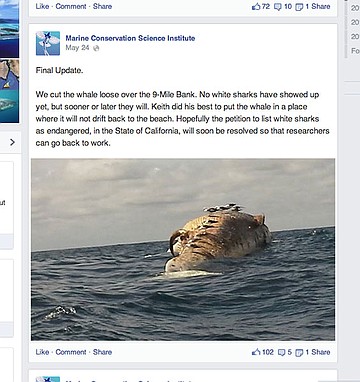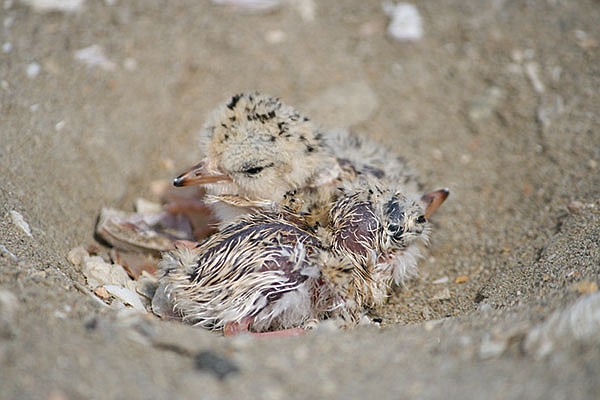 Facebook
Facebook
 X
X
 Instagram
Instagram
 TikTok
TikTok
 Youtube
Youtube

It’s a whale of a tale: a respected though sometimes controversial crew of shark researchers who wanted to use a dead whale to chum great white sharks for tagging discover they won’t be allowed to, because another shark-protection group triggered severe limits on tagging by trying to get white sharks on the state endangered-species list.
Instead, the rotting whale ends up on the beach just yards from a border sanctuary where two endangered species are in the midst of breeding season — with tiny hatchling birds running around.
And since dead whales attract predators both at sea and on land, a carcass — from an endangered species — that might have been bait for one challenged species instead becomes a danger to two others.
The shark men
The tale begins on May 19, when a dead fin whale, between 50´ and 60´ long, washed up at the Point Loma Wastewater Treatment Plant just north of Cabrillo National Monument.
The rule of the coast: whoever is in charge of the shoreline where the dead animal shows up is in charge of the clean-up, according to National Oceanographic and Atmospheric Administration biologist Susan Chivers.
By May 21, a crew led by “Sharktagger” Keith Poe, had committed to towing the whale out to use it to attract sharks — mako and great white — and tag them for research. Poe has been tagging mako sharks since 1994 and is one of the California Department of Fish & Wildlife’s top shark taggers.
“I’ve tagged over 4000 mako, thresher, great whites, and other sharks off Southern California,” Poe says in a phone interview.

The shark taggers, through the Fallbrook-based Marine Conservation Science Institute led by Michael Domeier, have a permit to use such carcasses from the National Marine Fisheries, according to NOAA spokesman Justin Viezbicke.
According to Dovi Kacev, a shark researcher with the Conservation Ecology Lab at San Diego State University, “Dr. Domeier has several peer-reviewed articles in the literature, and he has contributed to the body of research that suggests the sharks travel much farther than we thought,” Kacev said. “He is certainly recognized as experienced in shark tagging, and he’s as qualified as anyone to conduct the research.”
Domeier’s biography, on his agent’s website, says he “conceived the idea and science behind National Geographic’s series Expedition Great White and Shark Men, appearing in 18 episodes of these programs.”

But it’s not clear that Domeier, who lives in Hawaii while his institute is domiciled in Fallbrook, was involved in the towing that was done under the auspices of his nonprofit organization. Repeated attempts to contact Domeier — including messages left with his wife — and to obtain records from his nonprofit went without response.
The other shark men
Sharks are also a passion for Oceana, which describes itself as “the largest international organization focused solely on ocean conservation.” In August 2012, the group’s Northern California office applied to list the great white on the state endangered-species list.
The bid to get state endangered species protections had an important consequence — usually intended, of making “take” of the sharks off limits.
“‘Take’ is defined as pursue, hunt, capture, or kill,” says Craig Shuman, marine region manager for the California Department of Fish and Wildlife. “Tagging is viewed as take.”
As the Fish & Wildlife permit shows, tagging was suspended because of the endangered-species list application.
“One of the ironies of this is the California Endangered Species Act affects everyone, including researchers. It makes it harder to do research,” Shuman says. “People don’t think through the unintended consequences.”
Dr. Geoff Shester, the California campaign director for Oceana, says the state limits on research during the consideration divided shark researchers and didn’t serve the sharks.
“The species faces its greatest danger in the needless death of young sharks in fishing nets — over 200 pups are killed in fishing nets in Northern Mexico and California waters every year, about 80 percent of the babies end up dying in fishing nets,” Shester says. “The state put all its scrutiny into denying research permits when we know where the killing grounds are.”
Oceana’s application was based on the idea that there are about 339 adult and near-adult great whites — which led to an estimate of about 47 breeding females in the California Pacific region, he said.
Oceana’s application to get great whites on the endangered list was denied June 3, but until it was finalized (June 16) the prohibition against taking remained in place.
Shuman broke the news to Domeier after Poe’s crew was already towing the whale, he said.
“My last communication with Dr. Domeier, he said he was disappointed he could not do the tagging, but they were planning to continue the activity and do visual studies,” Shuman said.
The rope broke
Or did it? The way Keith Poe tells the story, the rotting fin whale he towed to sea from the Point Loma Waste Treatment plant broke free just minutes after he got word that the California Department of Fish and Wildlife wasn’t going allow the whale to be used to chum sharks.
“When the line the lifeguards tied broke, it recoiled like a shot and got tangled in my propeller,” said Poe, who was towing the carcass with his 31´ boat. “I actually jumped in off the boat and cleared the line that was tangled in my propeller.”
And then Poe watched the whale bob around in the water, about nine miles offshore. He started up the boat and steered back to shore.

The Marine Conservation Science Institute’s Facebook page entry on May 24, however, tells a different story: “We cut the whale loose over the 9-Mile Bank…. Keith did his best to put the whale in place so it won’t drift back to the beach.”
But on Saturday morning, May 24, the whale washed up on the beach less than a mile from the U.S.-Mexico border, at Border Field State Park.
For a few days the whale rolled around in the surf and drew hundreds of visitors to the park. “People were really curious to see this animal; there was a lot of interest,” refuge manager Chris Peregrin said.
For Peregrin, the carcass posed more than a nuisance problem.
“We were in a spot, because we had to dispose of it to protect our birds,” he said. “The whale attracted predators.”

It washed up the week that the California least tern and western snowy plover, birds that are on the federal endangered species list, are breeding. Indeed, the careful inspection by wildlife biologists turned up the tiny hatchlings wandering around on the beach between the roped-off breeding area and the whale, which by then smelled awful.
After a few days of trying to figure out the best way to deal with the whale, Peregrin found contractors to remove the carcass.
“The day we removed the whale, our wildlife biologists walked the area to make sure there weren’t any babies that had come in to the work area,” Peregrin said. “Once we were sure the area was clear, we focused on getting the job done as quickly as possible and getting out of there.”
The whale skull went to San Diego State University for research, and Native Americans gathered whale bones and parts for their traditional uses, Peregrin said.
But most of the whale was chopped up and hauled away for disposal.
The final tally for the whale tale: about $12,000 from the State Parks budget, not including staff time, Peregrin said.


It’s a whale of a tale: a respected though sometimes controversial crew of shark researchers who wanted to use a dead whale to chum great white sharks for tagging discover they won’t be allowed to, because another shark-protection group triggered severe limits on tagging by trying to get white sharks on the state endangered-species list.
Instead, the rotting whale ends up on the beach just yards from a border sanctuary where two endangered species are in the midst of breeding season — with tiny hatchling birds running around.
And since dead whales attract predators both at sea and on land, a carcass — from an endangered species — that might have been bait for one challenged species instead becomes a danger to two others.
The shark men
The tale begins on May 19, when a dead fin whale, between 50´ and 60´ long, washed up at the Point Loma Wastewater Treatment Plant just north of Cabrillo National Monument.
The rule of the coast: whoever is in charge of the shoreline where the dead animal shows up is in charge of the clean-up, according to National Oceanographic and Atmospheric Administration biologist Susan Chivers.
By May 21, a crew led by “Sharktagger” Keith Poe, had committed to towing the whale out to use it to attract sharks — mako and great white — and tag them for research. Poe has been tagging mako sharks since 1994 and is one of the California Department of Fish & Wildlife’s top shark taggers.
“I’ve tagged over 4000 mako, thresher, great whites, and other sharks off Southern California,” Poe says in a phone interview.

The shark taggers, through the Fallbrook-based Marine Conservation Science Institute led by Michael Domeier, have a permit to use such carcasses from the National Marine Fisheries, according to NOAA spokesman Justin Viezbicke.
According to Dovi Kacev, a shark researcher with the Conservation Ecology Lab at San Diego State University, “Dr. Domeier has several peer-reviewed articles in the literature, and he has contributed to the body of research that suggests the sharks travel much farther than we thought,” Kacev said. “He is certainly recognized as experienced in shark tagging, and he’s as qualified as anyone to conduct the research.”
Domeier’s biography, on his agent’s website, says he “conceived the idea and science behind National Geographic’s series Expedition Great White and Shark Men, appearing in 18 episodes of these programs.”

But it’s not clear that Domeier, who lives in Hawaii while his institute is domiciled in Fallbrook, was involved in the towing that was done under the auspices of his nonprofit organization. Repeated attempts to contact Domeier — including messages left with his wife — and to obtain records from his nonprofit went without response.
The other shark men
Sharks are also a passion for Oceana, which describes itself as “the largest international organization focused solely on ocean conservation.” In August 2012, the group’s Northern California office applied to list the great white on the state endangered-species list.
The bid to get state endangered species protections had an important consequence — usually intended, of making “take” of the sharks off limits.
“‘Take’ is defined as pursue, hunt, capture, or kill,” says Craig Shuman, marine region manager for the California Department of Fish and Wildlife. “Tagging is viewed as take.”
As the Fish & Wildlife permit shows, tagging was suspended because of the endangered-species list application.
“One of the ironies of this is the California Endangered Species Act affects everyone, including researchers. It makes it harder to do research,” Shuman says. “People don’t think through the unintended consequences.”
Dr. Geoff Shester, the California campaign director for Oceana, says the state limits on research during the consideration divided shark researchers and didn’t serve the sharks.
“The species faces its greatest danger in the needless death of young sharks in fishing nets — over 200 pups are killed in fishing nets in Northern Mexico and California waters every year, about 80 percent of the babies end up dying in fishing nets,” Shester says. “The state put all its scrutiny into denying research permits when we know where the killing grounds are.”
Oceana’s application was based on the idea that there are about 339 adult and near-adult great whites — which led to an estimate of about 47 breeding females in the California Pacific region, he said.
Oceana’s application to get great whites on the endangered list was denied June 3, but until it was finalized (June 16) the prohibition against taking remained in place.
Shuman broke the news to Domeier after Poe’s crew was already towing the whale, he said.
“My last communication with Dr. Domeier, he said he was disappointed he could not do the tagging, but they were planning to continue the activity and do visual studies,” Shuman said.
The rope broke
Or did it? The way Keith Poe tells the story, the rotting fin whale he towed to sea from the Point Loma Waste Treatment plant broke free just minutes after he got word that the California Department of Fish and Wildlife wasn’t going allow the whale to be used to chum sharks.
“When the line the lifeguards tied broke, it recoiled like a shot and got tangled in my propeller,” said Poe, who was towing the carcass with his 31´ boat. “I actually jumped in off the boat and cleared the line that was tangled in my propeller.”
And then Poe watched the whale bob around in the water, about nine miles offshore. He started up the boat and steered back to shore.

The Marine Conservation Science Institute’s Facebook page entry on May 24, however, tells a different story: “We cut the whale loose over the 9-Mile Bank…. Keith did his best to put the whale in place so it won’t drift back to the beach.”
But on Saturday morning, May 24, the whale washed up on the beach less than a mile from the U.S.-Mexico border, at Border Field State Park.
For a few days the whale rolled around in the surf and drew hundreds of visitors to the park. “People were really curious to see this animal; there was a lot of interest,” refuge manager Chris Peregrin said.
For Peregrin, the carcass posed more than a nuisance problem.
“We were in a spot, because we had to dispose of it to protect our birds,” he said. “The whale attracted predators.”

It washed up the week that the California least tern and western snowy plover, birds that are on the federal endangered species list, are breeding. Indeed, the careful inspection by wildlife biologists turned up the tiny hatchlings wandering around on the beach between the roped-off breeding area and the whale, which by then smelled awful.
After a few days of trying to figure out the best way to deal with the whale, Peregrin found contractors to remove the carcass.
“The day we removed the whale, our wildlife biologists walked the area to make sure there weren’t any babies that had come in to the work area,” Peregrin said. “Once we were sure the area was clear, we focused on getting the job done as quickly as possible and getting out of there.”
The whale skull went to San Diego State University for research, and Native Americans gathered whale bones and parts for their traditional uses, Peregrin said.
But most of the whale was chopped up and hauled away for disposal.
The final tally for the whale tale: about $12,000 from the State Parks budget, not including staff time, Peregrin said.
Comments